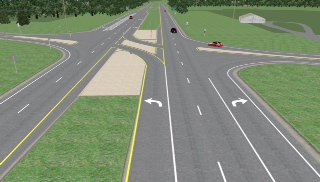Resources
In 2019-2020, MnDOT worked with a community panel to develop and evaluate options that would support the community’s vision for the corridor. The panel was comprised of local business owners, residents, motorists, emergency services, and officials from the township, city and county.
This Highway 71 corridor, from Highway 197 to Winter Sumac Road, will include intersection improvements of RCI's (Reduced Conflict Intersections) and a roundabout at Anne Street. Find more information on roundabouts here.
Reduced Conflict Intersections
Reduced Conflict Intersections decrease fatalities and injuries caused by T-bone crashes on four-lane divided highways. In some parts of the country RCIs are sometimes referred to as J-turns, R-CUTs, Michigan Lefts.
Benefits
- RCI's improve safety, with up to a 70 percent reduction in injury crashes nationwide
- Currently there are over 30 RCI’s in the state
- They’ve been built on some of the state’s most dangerous intersections
- There have been no fatal or severe injury crashes at any of them
- Minnesota’s first RCI was built o
 n Hwy 71 in Willmar in 2010
n Hwy 71 in Willmar in 2010
- Prior to construction the intersection averaged 9 crashes per year
- In the 10 years since, there have been only 3 total (none were severe/fatal)
How do they work?
While on Hwy 2
- Left turn onto cross street: enter left turn lane on Hwy 71, make a u-turn
- Left turn onto cross street: enter left turn lane on Hwy 71, make a u-turn
- Right turn onto cross street: no change
- Left turn onto cross street: no change.
While on Cross Street
- Right turn onto Hwy 71: no change
- Left turn onto Hwy 71: turn right onto Hwy 71, make a u-turn
- Cross intersection (to remain on cross street): turn right onto Hwy 71, make a u-turn, turn right onto cross street.
Why do they work?
Understanding reduced conflict intersections
With an RCI, drivers from the side street only have to be concerned with one direction of traffic on the highway at a time. You don’t need to wait for a gap in both directions to cross a major road. Traditional four-lane divided highway intersections have an elevated risk of severe right-angle crashes (commonly called “T-bone” crashes), especially for drivers attempting to cross all four lanes of traffic or turn left. At a traditional intersection, motorists from the side street need to look in both directions to cross a four-lane divided highway. Left turns require the same level of attention.

